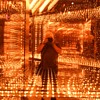Posted 12 years ago
 ericevans2
ericevans2
(52 items)
Unknown English Maker | Tailboard | Wet plate camera | 1850/60s | Quarter Plate.
Catalogue No. 0238.
Obviously early, basically a sliding box camera with bellows, this to me marks the transition from sliding box to the very early use of bellows, purely to extend the focusing range of the camera, and with no intention of enabling folding. This camera, with its diagonally braced, fixed tailboard, was never designed to fold. This again could indicate a very early date in the 1850s, before the idea of getting out of the studio was widely accepted. The bellows have chamfered corners, like the Carpentier camera of 1865, and my own Alphonse Bernoud camera, of 1850s-60s, both of which fold, so this is possibly earlier than either of those. So much for the theory that all early cameras have square bellows. In the course of its life, it could have been used for any process from Daguerreotype onwards. There are black collodion stains on the woodwork. Coming "new to the market" from a shed clearance, it was obviously professionally made, in well-finished mahogany, but had had some bodged modification before it came to me. The front panel had been roughly square holed to take a much later and inappropriate lens, and an attempt to fit a tripod bush had led someone to add some wooden side pieces, now removed, but unfortunately not without trace. The camera was never intended to have a tripod bush. Cameras of this period were meant to be used on the flat surface of a studio camera stand, although I do have a sliding box camera with marks where a G-clamp was used to hold the stand and camera together, hence the later evolution of the tripod bush. I have made a sympathetic restoration, with an appropriate period, 6 inch Lerebours & Secretan Petzval portrait lens which is probably worth more than I paid for the camera, but to my knowledge of the subject, is authentic to what the camera needed. As a researcher, I welcome any further and better information or correction.













